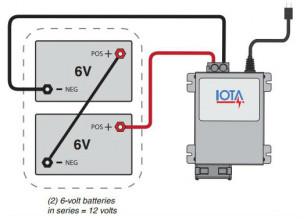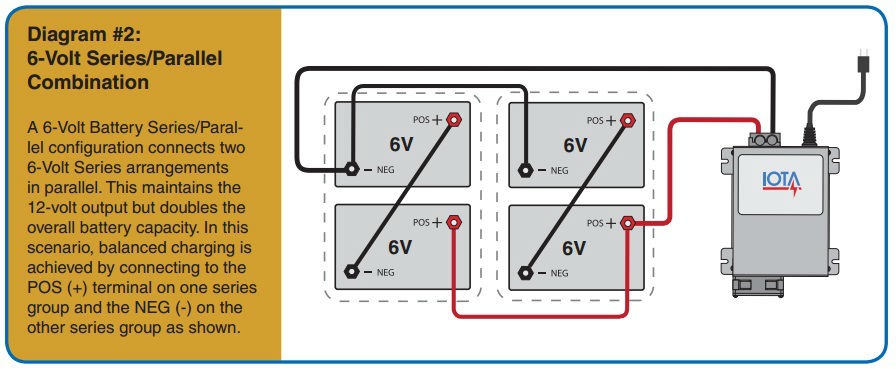How to Connect & Charge Batteries in Series / Parallel
How to Connect & Charge Batteries in Series / Parallel
If you want to know about charging batteries in series and parallel then you have probably asked or are wondering what the advantage is of connecting batteries in series / parallel. This tutorial will provide easy to understand diagrams and will share reasons why you would use this battery configuration.
If you need to know about charging parallel batteries then click over to our tutorial on perfectly balanced charging. You may discover why your batteries have not been lasting as long as you thought they should!
Before we dive in any further, we would like to pause and thank our friends over at Iota Engineering for creating the graphics. Iota manufactures the very popular DLS line of power supply chargers found in many of our customers fifth wheels, RVs, and telecommunications applications. The charger depicted in some of the images will resemble their DLS charger and will have their logo emblazed on it.
Batteries Connected in Series
 When connecting or charging batteries in series your goal is to increase the output of your batteries nominal voltage rating. To do this you need to connect the POS (+) terminal of the first battery to the NEG (-) terminal of the second battery. If there are only two batteries in our series we would then take a wire from the NEG (-) terminal of the first battery and a wire from the POS (+) of the second battery to the motor or charger.
When connecting or charging batteries in series your goal is to increase the output of your batteries nominal voltage rating. To do this you need to connect the POS (+) terminal of the first battery to the NEG (-) terminal of the second battery. If there are only two batteries in our series we would then take a wire from the NEG (-) terminal of the first battery and a wire from the POS (+) of the second battery to the motor or charger.
The positive of the first battery and negative of the second battery DO NOT connect to each other! The series configuration DOES NOT increase your amp hour capacity; it only increases your voltage output.
If you need to connect more than two batteries in series, you would make the following adjustment. Instead of connecting the POS (+) of the second battery to the charger, you would connect it to the NEG (-) of the third battery. You would continue this positive to negative pattern until you reach your last battery. The POS (+) of the last battery in the series will connect to your application / charger.
For most of our customers, 6-volt batteries will be used in their series/parallel configuration. The images used here will focus on this setup, but if you are using 12-volt batteries simply swap the numbers; the connections will be the same.
Series / Parallel Combination
The goal of the series / parallel configuration is to increase BOTH the voltage and capacity. Batteries that are ONLY in parallel keep the same voltage and increase their capacity. Batteries that are ONLY in series keep the same capacity and increase their voltage. Combining the two provides the best of both worlds; increasing Both voltage and amperage.
The series parallel combination can look confusing when you first come across a jumble of wires atop your battery bank. Hopefully this diagram will simplify what you are seeing.
As you can see, we now have a LEFT battery bank and a RIGHT battery bank (the dotted line around each). The left bank has an extra black wire connected to the NEG (-) terminal of battery number one. This wire attaches to the NEG (-) terminal of the corresponding battery bank to the right (battery number three if we keep our numbering sequence).
The same pattern can be seen with the positive terminals. The right battery bank has an extra red wire on the POS (+) terminal of battery number four. This wire connects back to the POS (+) terminal of battery number two in the left bank.
The extra red and black wires are what tie the system together in parallel. They are what allow the system to increase, in this case double, the amp hour capacity. If you are adding more battery banks to increase capacity even further, simply push the charger off to the right and follow the pattern already established with the NEG (-) to NEG (-) black wire and the POS (+) to POS (+) red wires.
A Battery Word Equation and Special Note
Parallel:
B1 POS (+) to B2 POS (+) and B1 NEG (-) to B2 NEG (-)
Battery Capacity x Number of Batteries = Battery Bank Capacity
Series:
B1 POS (+) to B2 NEG (-) with B1 NEG (-) and B2 POS (+) to Application
Voltage of Battery x Number of Batteries = Battery Bank Voltage
Series/Parallel:
Battery Bank Voltage + (Battery Capacity x Battery Banks) = System Capacity and Voltage
Note: that for optimal battery bank and charging performance, the batteries in the bank should be of the same manufacturer and model, as well as the same AH rating, age, condition, and state of charge [SOC].
One major reason for utilizing the series parallel combination is simply due to space restrictions and the need to maximize capacity storage. Sometimes you can gain higher amperage in a different or smaller footprint using 6V batteries rather than 12V batteries.
There are many that grew up with the idea that the longevity of 6V batteries with their thicker plates will far outweigh that of 12-volt deep cycle batteries. To gain this extra durability they prefer to use only 6-volt batteries and thus need to create a series parallel configuration.
Hopefully this tutorial bridged the gap in your understanding series connections and will provide you the confidence needed help connect and charge your batteries in series and parallel.
RELATED Article: How to Charge Lead Acid Marine and RV Batteries in Parallel







May be using diodes?